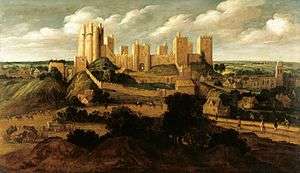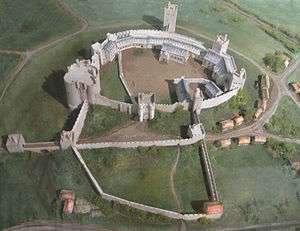Pontefract Castle

Coordinates: 53°41′44″N 1°18′14″W / 53.69556°N 1.30389°W Pontefract (or, Pomfret) Castle is a castle in the town of Pontefract, in West Yorkshire, England. King Richard II is thought to have died there. It was the site of a series of famous sieges during the 17th-century English Civil War.
History

The castle, on a rock to the east of the town above All Saints' Church,[1] was constructed in approximately 1070 by Ilbert de Lacy.[2] on land which had been granted to him by William the Conqueror as a reward for his support during the Norman Conquest. There is, however, evidence of earlier occupation of the site. Initially the castle was a wooden structure which was replaced with stone over time.[3] The Domesday Survey of 1086 recorded "Ilbert's Castle" which probably referred to Pontefract Castle.[4]
Robert de Lacy failed to support King Henry I during his power struggle with his brother, and the King confiscated the castle from the family during the 12th century.[3] Roger de Lacy paid King Richard I 3,000 marks for the Honour of Pontefract, but the King retained possession of the castle. His successor, King John gave Lacy the castle in 1199, the year he ascended the throne. Roger died in 1213 and was succeeded by his eldest son, John. However, the King took possession of Castle Donington and Pontefract Castle.[5] The de Lacys lived in the castle until the early 14th century.[3] It was under the tenure of the de Lacys that the magnificent multilobate donjon was built.[2]
In 1311 the castle passed by marriage to the estates of the House of Lancaster. Thomas, Earl of Lancaster (1278–1322) was beheaded outside the castle walls six days after his defeat at the Battle of Boroughbridge, a sentence placed on him by King Edward II himself in the great hall. This resulted in the earl becoming a martyr with his tomb at Pontefract Priory becoming a shrine.[3] It next went to Henry, Duke of Lancaster and subsequently to John of Gaunt, third son of King Edward III. He made the castle his personal residence, spending vast amounts of money improving it.
Richard II
In the closing years of the 14th century, Richard II had banished John of Gaunt’s son Henry Bolingbroke, Duke of Hereford from the country and with the death of John of Gaunt, Duke of Lancaster in 1399, much of Bolingbroke's patrimony was being given away by Richard II to his favourites. The castle at Pontefract was among such properties under threat which roused Bolingbroke to return to England to claim his rights to the Duchy of Lancaster and the properties of his father. Act 2, scene 1, of Shakespeare's play Richard II relates Bolingbroke’s homecoming in the words of Northumberland in the speech of the eight tall ships:-
Then thus: I have from Port Le Blanc,
A bay in Brittany, receiv’d intelligence,
That Harry Duke of Herford, Rainold Lord Cobham,
Thomas, son and heir to th’ Earl of Arundel,
That late broke from the Duke of Exeter,
His brother, Archbishop late of Canterbury,
Sir Thomas Erpingham, Sir John Ramston,
Sir John Norbery, Sir Robert Waterton, and Francis Quoint—
All these, well furnished by the Duke of Brittany
With eight tall ships, three thousand men of war,
Are making hither with all due expedience,
And shortly mean to touch our northern shore
When he landed at Ravenspur on the Humber he made straight way for his castle at Pontefract. The King, being in Ireland at the time, was in no position to oppose Bolingbroke who deposed Richard and took the crown for himself as Henry IV.
.jpg)
Richard II was captured by Henry Bolingbroke's supporters in August 1399 and initially imprisoned in the tower. Sometime before Christmas that year he was moved to Pontefract Castle (via Knaresborough) where he remained under guard until his death, perhaps on 14 February 1400.[6] William Shakespeare's play Richard III mentions this incident:
Pomfret, Pomfret! O thou bloody prison,
Fatal and ominous to noble peers!
Within the guilty closure of thy walls
Richard the second here was hack'd to death;
And, for more slander to thy dismal seat,
We give thee up our guiltless blood to drink.
Various chroniclers suggest that Richard was starved to death by his captors, and others suggest he starved himself. A contemporary French chronicler suggested that Richard II had been hacked to death, but this is, according to the ODNB, "almost certainly fictitious".[6]
Tudor Era
In 1536, the castle's guardian, Thomas Darcy, 1st Baron Darcy de Darcy handed over the castle to the leaders of the Pilgrimage of Grace, a Catholic rebellion from northern England against the rule of King Henry VIII. Lord Darcy was executed for this alleged "surrender," which the king viewed as an act of treason.
In 1541, during a royal tour of the provinces, it was alleged that King Henry's fifth wife, Queen Catherine Howard, committed her first act of adultery with Sir Thomas Culpeper at Pontefract Castle, a crime for which she was apprehended and executed without trial. Mary, Queen of Scots was lodged at the castle on 28 January 1569, travelling between Wetherby and Rotherham.[7]
Royalist stronghold

The castle has been a ruin since 1649 when it was held as a Royalist stronghold during the English Civil War [8] and besieged at least three times by Parliamentarian forces, the latter being responsible for the castle's present dilapidated state and many of its scars. Pontefract Castle was noted by Oliver Cromwell, leader of the Parliamentarians, as "one of the strongest inland garrisons in the kingdom".[2]
Apparently the slighting of the castle at the conclusion of the Second English Civil War had the full support of the surrounding population. They were grateful to destroy the castle and thus stop the fighting in their area. In the view of the locals, the castle was a magnet for trouble.[3]
It is still possible to visit the castle's 11th-century cellars, which were used to store military equipment during the civil war.
Preservation
Little survives of what "must have been one of the most impressive castles in Yorkshire" other than parts of the curtain wall and excavated and tidied inner walls. It had inner and outer baileys. Parts of a 12th-century wall and the Piper Tower's postern gate and the foundations of a chapel are the oldest remains. The ruins of the Round Tower or keep are on the 11th-century mound. The Great Gate flanked by 14th-century semi-circular towers had inner and outer barbicans. Chambers excavated into the rock in the inner bailey possibly indicate the site of the old hall and the North Bailey gate is marked by the remains of a rectangular tower.[1]
The castle has several unusual features. The donjon has a rare Quatrefoil design. Other examples of this type of Keep are Clifford's Tower, York and at the Château d'Étampes in France. Pontefract also has an torre albarrana, a fortification almost unknown outside the Iberian Peninsular. Known as the Skillington Tower, the detached tower was attached to the north wall by a bridge. Its purpose was to increase the defender's range of flanking fire.[9]
Wakefield Council, who own the site, commissioned William Anelay Ltd to begin repairs on the castle in September 2015, but work stopped in November 2016 when Anelay went into administration. The Council then engaged Heritage Building & Conservation (North) Ltd, who began work on the site in March 2017. A new visitor centre and cafe were opened in July 2017; but in April 2018 the council announced that they had terminated the contract with HB&C (North) Ltd, as no work had been done since mid-March, and they had not had any reassurances that the work would restart. The council were looking for a new contractor, and hoped that work would restart early in 2019. [10]
See also
References
- 1 2 Pevsner & Radcliffe 1967, p. 394.
- 1 2 3 "The Duchy of Lancaster – Yorkshire". www.duchyoflancaster.co.uk. Archived from the original on 17 April 2013. Retrieved 19 April 2013.
- 1 2 3 4 5 "Pontefract Castle Index". www.pontefractus.co.uk. Archived from the original on 16 May 2008. Retrieved 22 July 2008.
- ↑ Harfield 1991, p. 383.
- ↑ Brown 1959, p. 255.
- 1 2 Tuck 2004.
- ↑ Calendar State Papers Scotland, vol.2 (1900), p.612
- ↑ "Pontefract Castle". www.wakefieldmuseums.org. Archived from the original on 15 September 2008. Retrieved 22 July 2008.
- ↑ "Torre Albarrana". www.castlesofspain.co.uk. Retrieved 16 July 2018.
- ↑ Drysdale, Laura (26 April 2018). "£3.5m Pontefract Castle restoration project grinds to a halt for a second time after scrapping of contractor". The Yorkshire Post. Retrieved 7 July 2018.
Bibliography
- Brown, Reginald Allen (April 1959), "A List of Castles, 1154–1216", The English Historical Review, 74 (291): 249–280, doi:10.1093/ehr/lxxiv.291.249, JSTOR 558442
- Harfield, C. G. (1991), "A Hand-list of Castles Recorded in the Domesday Book", English Historical Review, 106: 371–392, doi:10.1093/ehr/CVI.CCCCXIX.371, JSTOR 573107
- Pevsner, Nicholas; Radcliffe, Enid (1967), Yorkshire: The West Riding, The Buildings of England (2 ed.), Penguin Books, ISBN 0-14-071017-5
- Tuck, Anthony (2004), Richard II (1367–1400), king of England and lord of Ireland, and duke of Aquitaine, Oxford Dictionary of National Biography, Oxford University Press, doi:10.1093/ref:odnb/23499
External links
| Wikimedia Commons has media related to Pontefract Castle. |